Understanding Men's Body Fat Percentage: What You Need to Know

Body Fat Percentage for Men: A Comprehensive Guide
Last updated: June 6, 2025
Wondering about the healthy body fat percentage men should aim for—and how to measure it accurately? If you searched for “body fat percentage men,” you’re in the right place. This guide breaks down evidence-based ranges, step-by-step measurement examples, and actionable strategies to hit your goals.
Quick-Look Worksheet & Tools
• Body-Fat Tracking Log Template – Use the template section below to record your numbers and monitor changes over time.
• DEXA Scan booking – Ready for the gold standard? Find a BodySpec scan near you.
What Is Body-Fat Percentage?
Body-fat percentage (BF%) tells you what slice of your total weight is made up of fat tissue, as opposed to lean mass (muscle, organs, water) and bone.
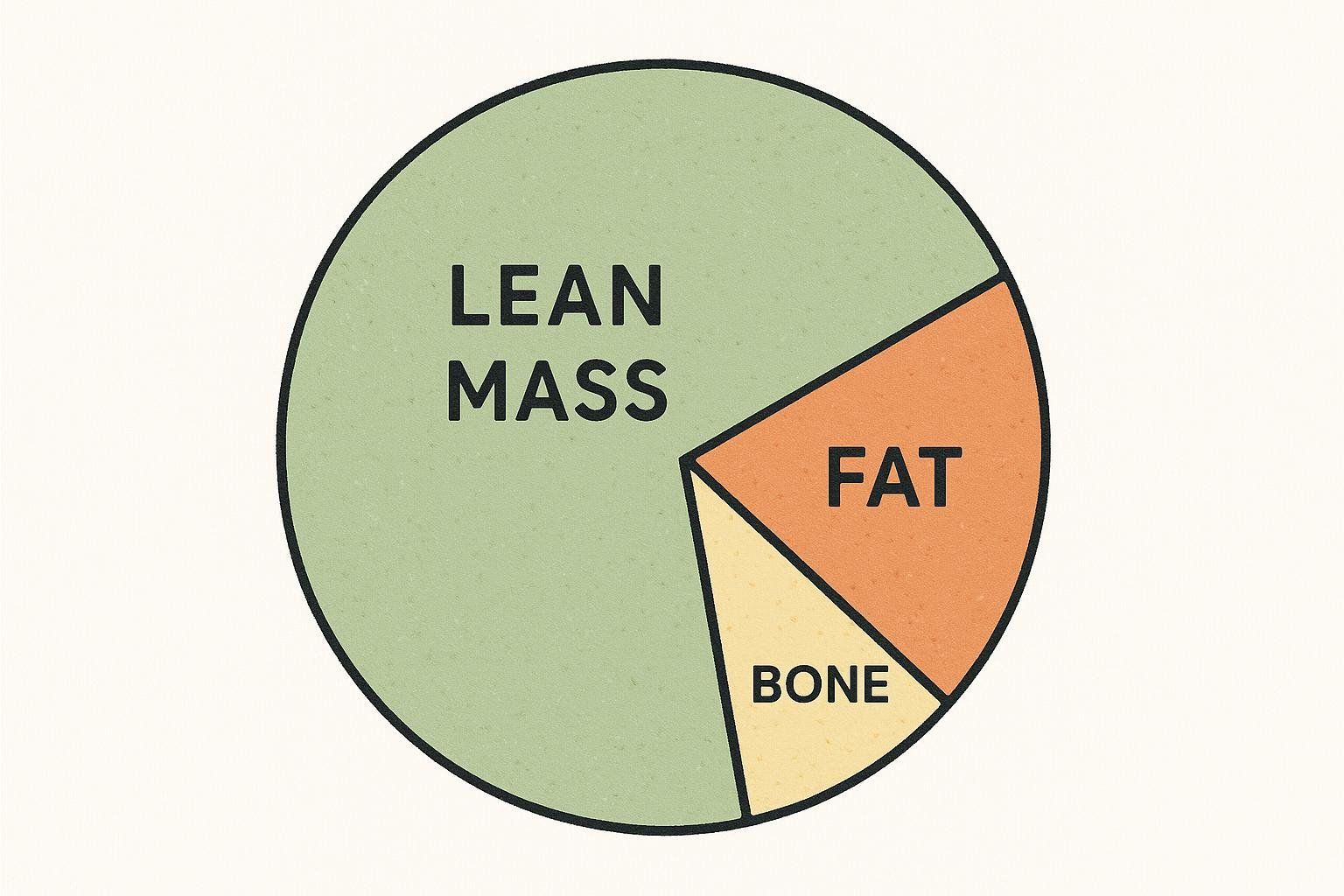
Unlike BMI—which can mislabel muscular men as “overweight”—BF% speaks directly to health risk, athletic performance, and aesthetics. Research shows that higher BF% in men is strongly associated with insulin resistance, cardiovascular disease, and lower testosterone levels (Harvard Health Publishing, 2024).
Essential vs. Storage Fat
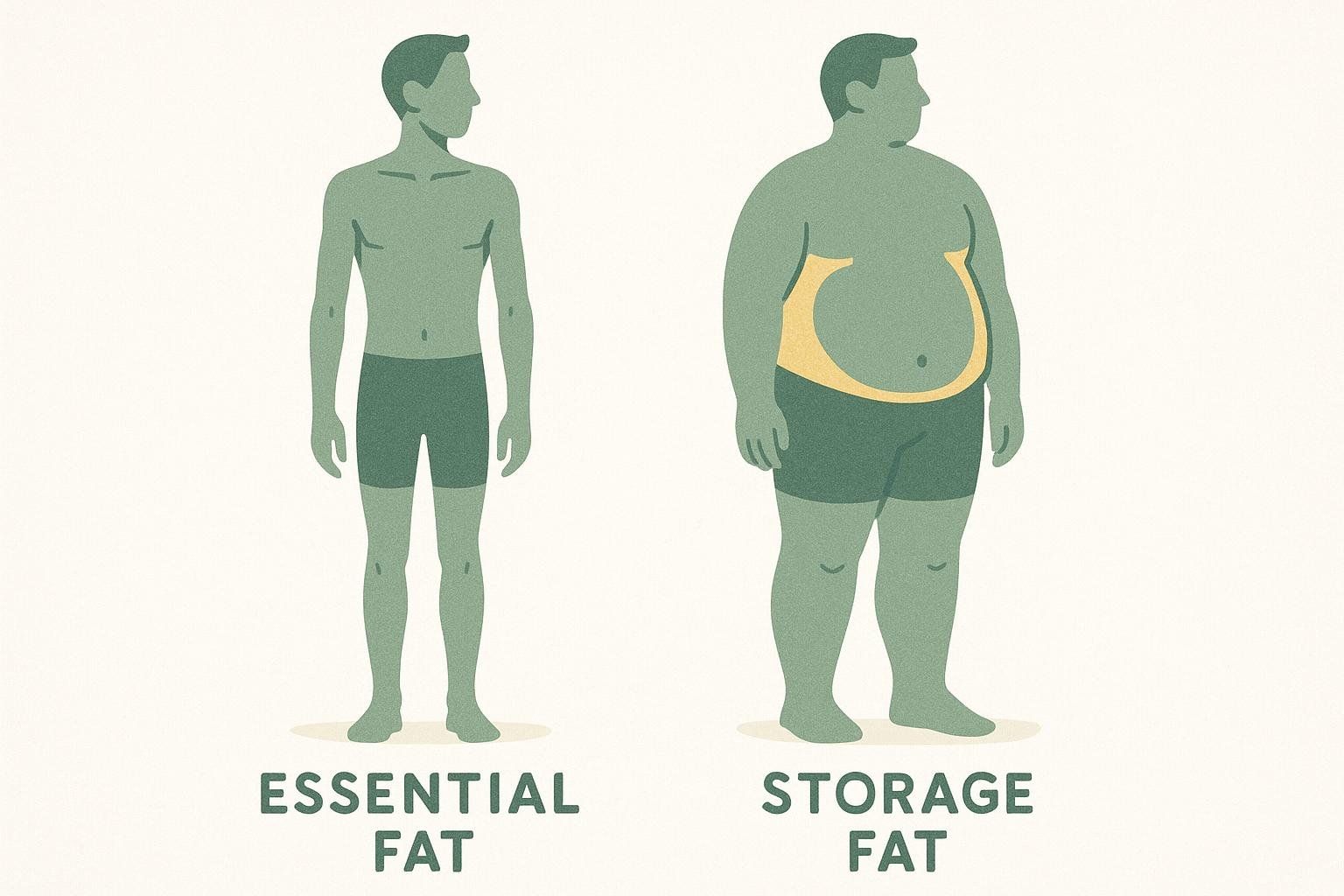
- Essential fat (2–5 %) – The minimum amount required for survival.
- Storage fat – Energy reserves and insulation. Too little can impair hormones; too much increases chronic-disease risk.
Healthy Body-Fat Percentage Ranges for Men
The American Council on Exercise guidelines (ACE) categorize BF% for health and fitness, but age matters. Below is a composite chart combining ACE categories with 2024 NHANES percentile data.
| Age | Essential | Athletic / Lean | Fitness | Average (Healthy) | Obese |
|---|---|---|---|---|---|
| 20–29 | 2–5 % | 6–13 % | 14–17 % | 18–24 % | ≥25 % |
| 30–39 | 2–5 % | 6–14 % | 15–18 % | 19–25 % | ≥26 % |
| 40–49 | 2–5 % | 6–16 % | 17–20 % | 21–26 % | ≥27 % |
| 50–59 | 2–5 % | 6–17 % | 18–22 % | 23–28 % | ≥29 % |
| 60+ | 2–5 % | 6–18 % | 19–23 % | 24–29 % | ≥30 % |
Sources: American Council on Exercise guidelines; CDC NCHS Data Brief 508 (2024).
What Range Should You Aim For?
- Visible abs? Many coaches note that abdominal definition typically emerges around 10–14 % body fat in younger men and 12–16 % in men over 40 (Henselmans, 2024).
- Health-risk reduction? Hitting <22 % significantly cuts cardiometabolic risk (Potter et al., JCEM 2024).
- Performance sports? Analyses of elite track athletes show male sprinters commonly maintain 8–10 % body fat, while endurance specialists cluster around 10–15 % (Dengel & Dengel, 2023).
Why BF% Beats the Scale (and BMI)
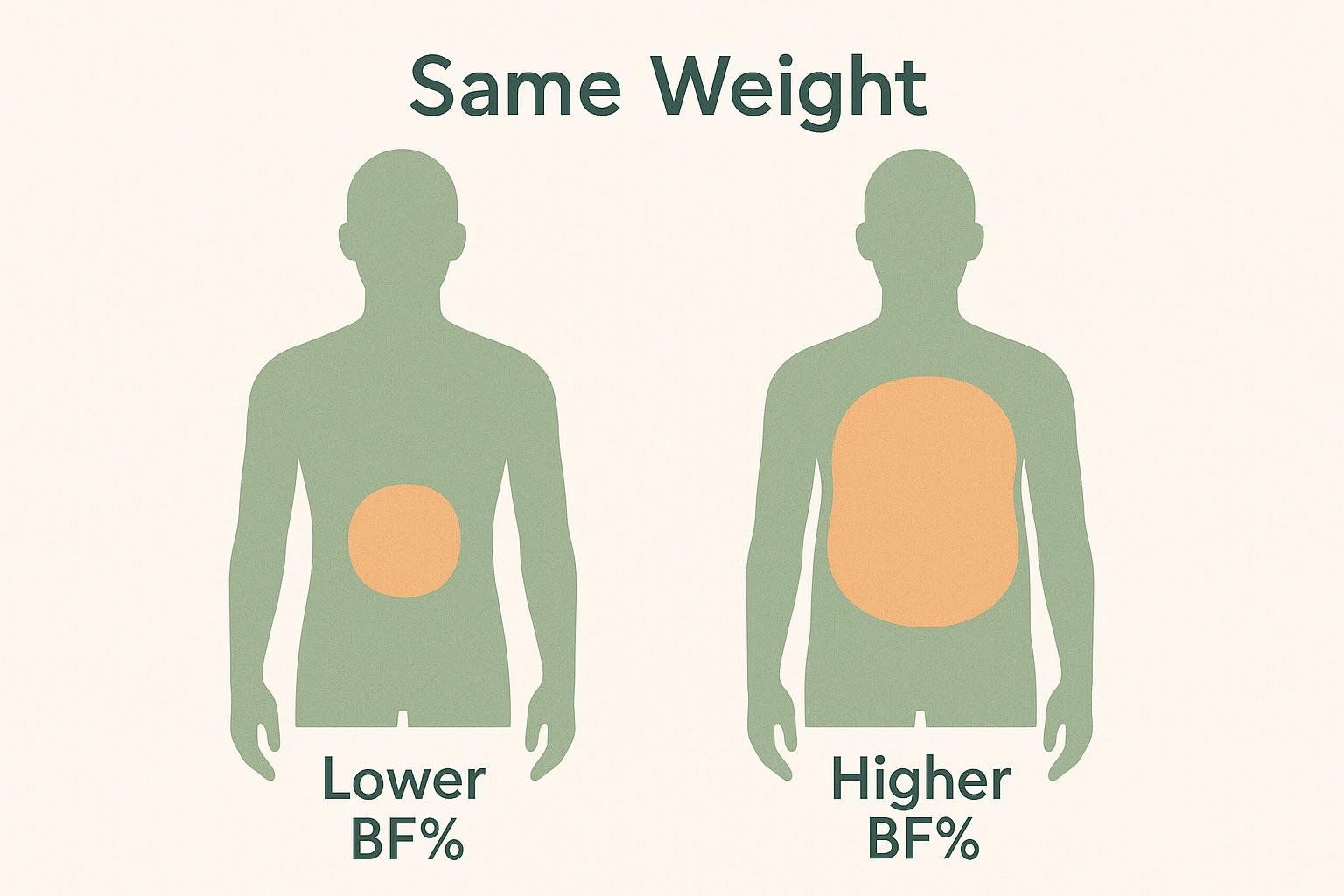
- Reveals hidden fat – Two men can weigh 190 lb; one at 12 % BF has ~23 lb fat, the other at 25 % BF carries ~48 lb. Their health-risk profiles aren’t the same.
- Tracks recomposition – BF% falls even when weight stays flat because you gained muscle while losing fat.
- Predicts disease risk better than BMI – A 2022 systematic review of 29 cohort studies found body-fat percentage to be a stronger predictor of all-cause mortality than BMI in both sexes (Jayedi et al., 2022).
👉 Related read: BMI vs. Body-Fat Percentage: Which Reflects Your Health Better?
How to Measure Body-Fat: Methods Compared
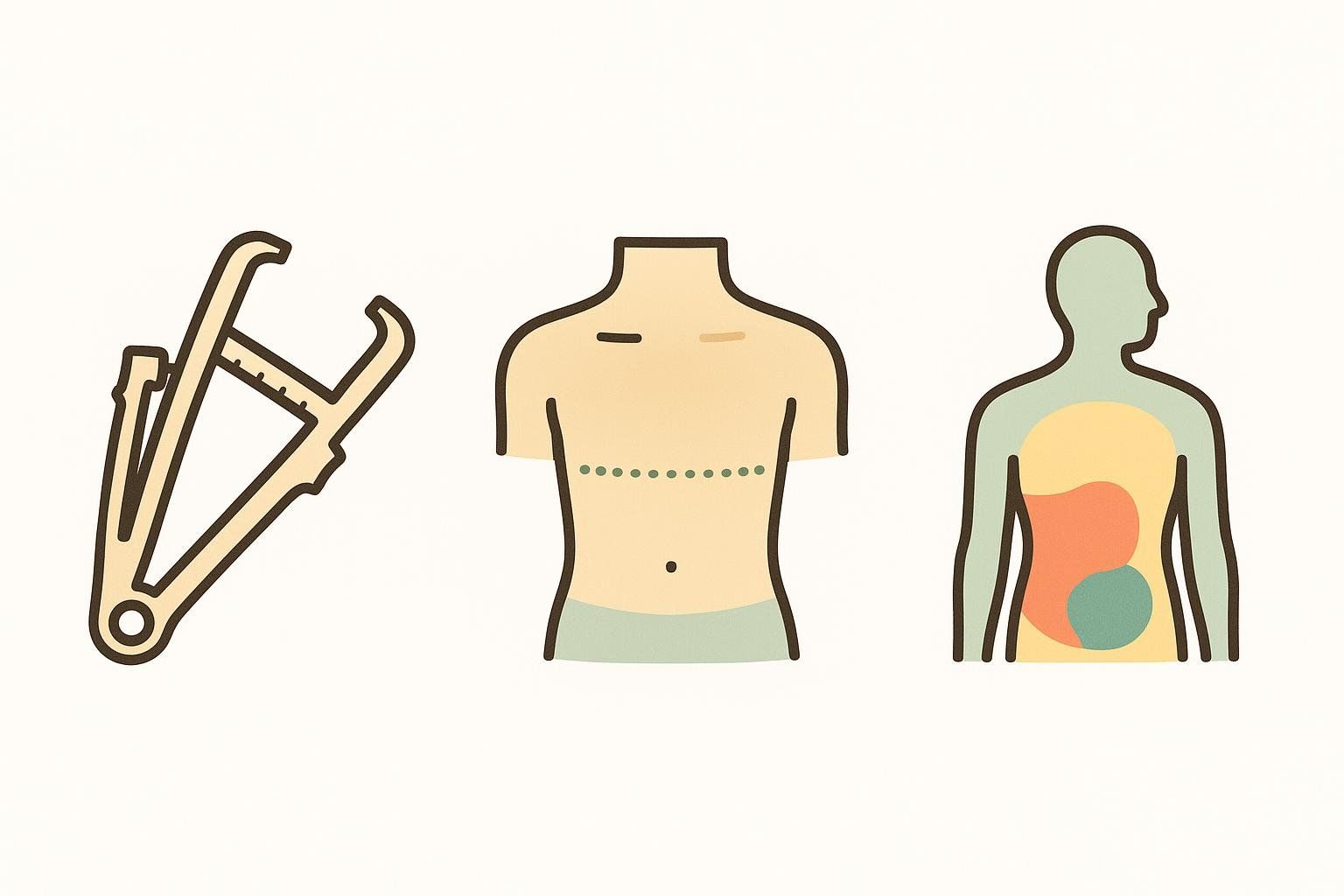
| Method | Accuracy | Pros | Cons | Best For |
|---|---|---|---|---|
| DEXA Scan | ±1 % | Measures fat, lean, bone; regional & visceral data; quick (10 min) | Requires appointment; small X-ray dose | Anyone seeking detailed, gold-standard data |
| Skin-fold Calipers | ±3–4 % (if skilled) | Cheap; portable | User error; limited visceral insight | Coaches, fitness enthusiasts |
| Navy Tape (circumference) | ±4–6 % | Only a tape measure needed | Sensitive to posture & tape tension | Home tracking in a pinch |
| Bioelectrical Impedance (BIA Scale) | ±3–8 % | Fast; daily trends | Hydration & meal timing skew results | Trend-minded consumers |
Persona Shortcuts
- Young Fitness Enthusiast – Calipers for weekly check-ins, DEXA monthly or quarterly.
- Middle-Aged Health Seeker – DEXA quarterly to monitor visceral fat; BIA for interim trends.
- Fitness Professional – Combine caliper or tape data with monthly or quarterly DEXA scans to educate clients and validate training programs.
Step-by-Step Example Calculations
1. Jackson & Pollock 3-Site (Men)
Required inputs (example):
• Chest, Abdomen, Thigh skinfolds = 10 mm, 18 mm, 20 mm
• Sum of skinfolds (SSS) = 48 mm
• Age = 30 years
Generic formula:
BD = 1.10938 – (0.0008267 × SSS) + (0.0000016 × SSS²) – (0.0002574 × Age)
Plug in values:
BD = 1.10938 – (0.0008267 × 48) + (0.0000016 × 2304) – (0.0002574 × 30)
BD = 1.10938 – 0.0397 + 0.0037 – 0.0077
BD = 1.0657 g/cm³
Convert to BF% (Siri equation):
BF% = ((4.95 / 1.0657) – 4.50) × 100 ≈ 14.5 %
2. U.S. Navy Tape Method (inches version)
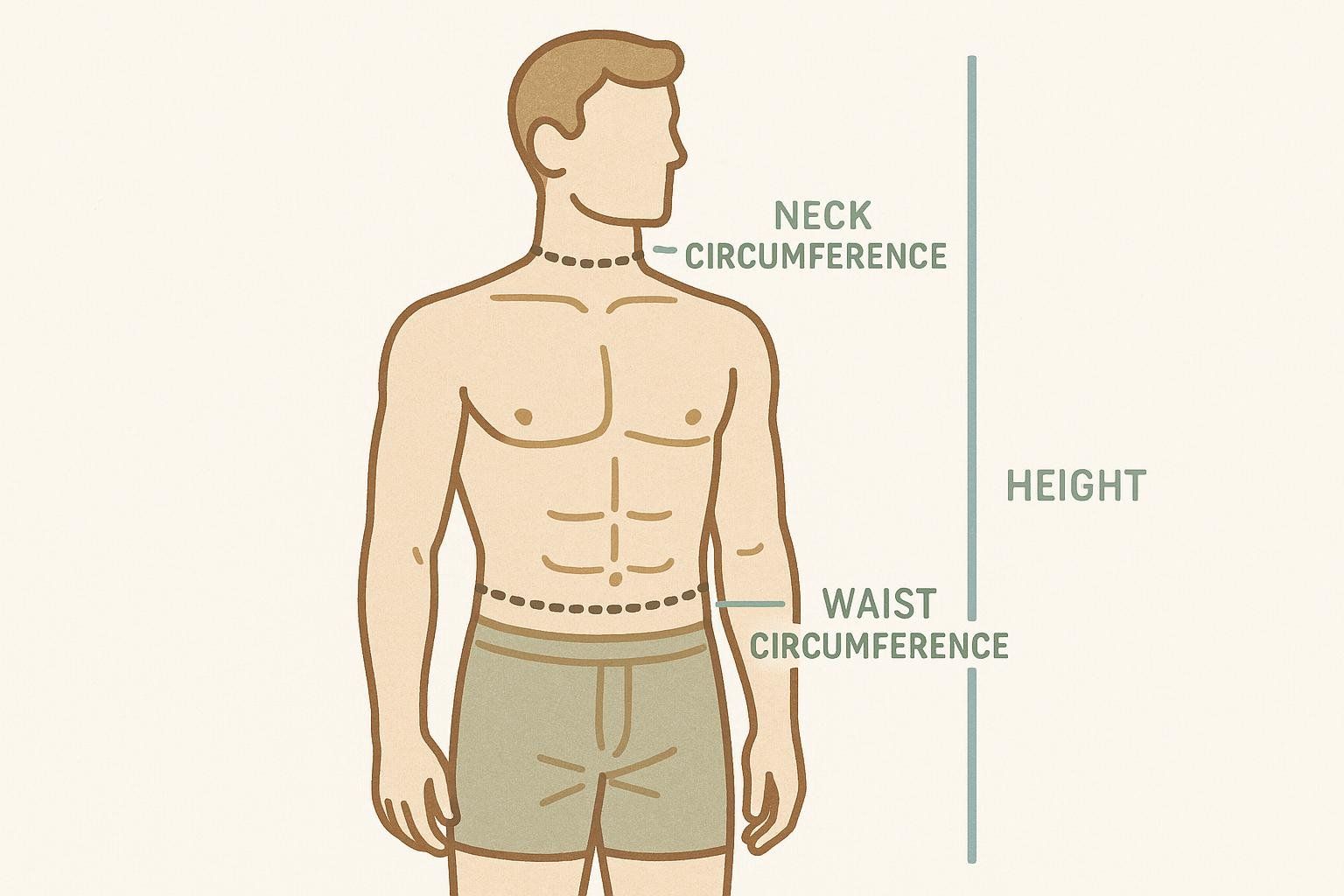
Required inputs (example):
• Waist = 34 in
• Neck = 16 in
• Height = 70 in
Formula (men, inches):
BF% = 86.010 × log10(Waist – Neck) – 70.041 × log10(Height) + 36.76
Plug in values:
BF% = 86.010 × log10(34 – 16) – 70.041 × log10(70) + 36.76
= 86.010 × 1.2553 – 70.041 × 1.8451 + 36.76
= 107.96 – 129.24 + 36.76
= 15.5 %
📊 Takeaway: Field methods can vary by 2–4 %. Use the same tool consistently—or calibrate with an occasional DEXA scan.
Body-Fat Tracking Log Template
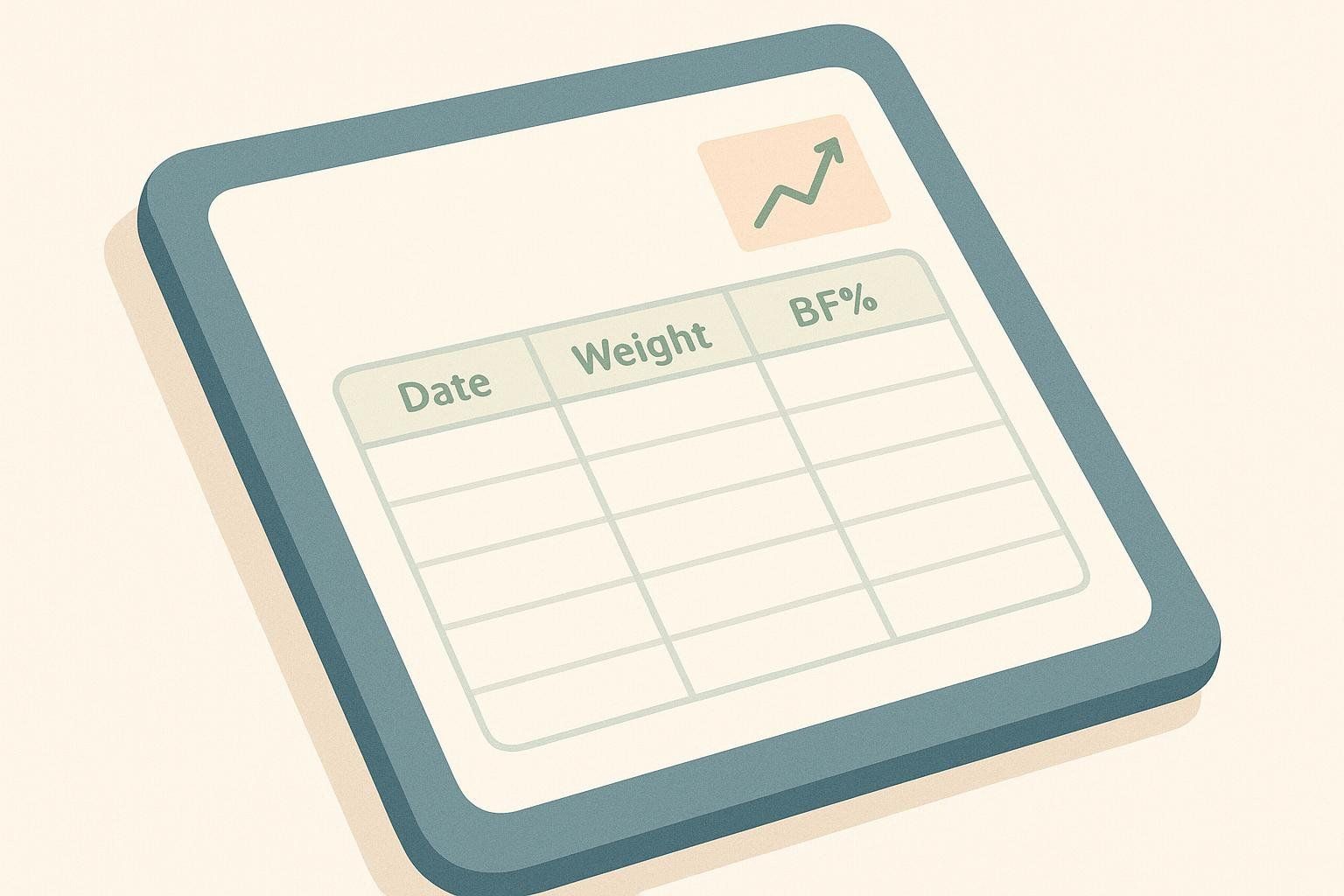
Use the table structure below as a template—copy it into your favorite spreadsheet or note-taking app to track your progress.
| Date | Weight (lb) | Measurement Method | Raw Inputs (mm or in) | Calculated BF% | Goal BF% | Notes |
|---|---|---|---|---|---|---|
How Often Should Men Measure Body-Fat?
- Cutting phase (12 weeks) – Every 2–4 weeks.
- Maintenance – Every 6–8 weeks.
- Health monitoring – At least twice per year with DEXA for visceral-fat tracking.
Related: Visceral Fat Level Chart: Understanding Your Health Risks
Action Plans by Persona
Young Fitness Enthusiast (Target 12–15 %)

- Training: Push/pull/legs 5×/week; add 2 HIIT sessions.
- Nutrition: 1.6–2.2 g protein/kg; calorie deficit of 300–500 kcal.
- Progress: Track weekly with calipers; schedule a monthly or quarterly DEXA.
Middle-Aged Health Seeker (Target 18–22 %)
- Training: 3×/week resistance + 150 min moderate cardio.
- Nutrition: Emphasize fiber (25 g+), prioritize lean protein at each meal.
- Medical: Discuss BF% goals with your clinician—especially if managing hypertension or pre-diabetes; plan quarterly DEXA scans.
Fitness Professional (Coach Toolkit)
- Show data: Use client DEXA reports to highlight visceral-fat visuals.
- Compare methods: Demonstrate caliper or tape measurements and discuss error margins.
- Educate: Leverage the evidence-based ranges and method comparisons in this guide; schedule monthly or quarterly DEXA scans with clients for objective feedback.
Bottom Line & Next Steps
For men, a healthy body-fat percentage usually lands between 10–22 % depending on age and goals. Select a measurement method you can repeat consistently, aim for incremental improvements, and verify progress with a periodic DEXA scan.
Ready to see your exact numbers? Book a BodySpec DEXA scan to get your fat, muscle, and bone data in 10 minutes.
FAQ
What body-fat percentage is considered obese for men?
Obesity thresholds rise slightly with age. According to ACE, men are considered obese at ≥25 % (20–29 years), ≥26 % (30–39 years), ≥27 % (40–49 years), ≥29 % (50–59 years), and ≥30 % (60 + years).
Can I reduce body-fat without losing weight?
Yes—through body recomposition. Combine resistance training with adequate protein to build muscle while losing fat; your scale weight may stay similar while BF% drops.
Is DEXA safe?
A full-body DEXA exposes you to about as much radiation as eating four bananas—far below medical X-ray levels. Learn more in Do DEXA Scans Have Radiation? Yes, About As Much as Eating 4 Bananas.
Citations
- American Council on Exercise (ACE). “Body-Fat Percentage—Average and Obese Ranges.” Accessed April 2025.
- Harvard Health Publishing. “What is considered a healthy body-fat percentage as you age?” Updated 2024.
- Centers for Disease Control and Prevention. NCHS Data Brief 508. 2024.
- Potter AW, Chin GC, Looney DP, Friedl KE. “Defining Overweight and Obesity by Percent Body Fat Instead of Body Mass Index.” Journal of Clinical Endocrinology & Metabolism, 2024; doi:10.1210/clinem/dgae341.
- Jayedi A, et al. “Body fat and risk of all-cause mortality: a systematic review and dose-response meta-analysis.” International Journal of Obesity, 2022.
- Henselmans M. “Body-Fat Percentage Pictures: A Visual Guide for Men.” 2024.
- Dengel DR & Dengel OH. “Body Composition – Methods and Importance for Performance and Health.” Techniques Magazine via Coaches Insider, 2023.


